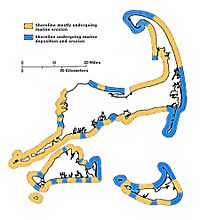Deposition (geology)

Deposition in geology means when tiny pieces of rocks, dirt or sand are carried away by water, wind or ice and are then placed or dropped in a new location. Imagine you are playing outside, and you pick up a handful of sand from a sandbox. If you walked to another part of the park and dropped some of the sand on the grass, you just created a little deposition site!
Deposition can happen in lots of different ways. For example, if a river is moving really fast and has a lot of water flowing through it, it can carry rocks and dirt along with it. When the river starts slowing down, all that heavy stuff the water was carrying falls to the bottom and stays there, creating a layer of sediment. Similar things can happen with glaciers, which are huge chunks of ice that move slowly across the ground. As glaciers move, they can pick up rocks and dirt, and then drop them when they melt.
Over time, all the sediment that gets deposited in one place can build up and create layers of rock, sand or dirt. These layers can tell us a lot about the history of an area! For example, if you looked at the layers of rock exposed in a cliff, you might be able to see different types of sediment from different time periods. Layers of sediment can also contain fossils, which are the remains of plants and animals that lived a long time ago. By studying these layers, scientists can learn about how the earth has changed over millions of years.
Deposition can happen in lots of different ways. For example, if a river is moving really fast and has a lot of water flowing through it, it can carry rocks and dirt along with it. When the river starts slowing down, all that heavy stuff the water was carrying falls to the bottom and stays there, creating a layer of sediment. Similar things can happen with glaciers, which are huge chunks of ice that move slowly across the ground. As glaciers move, they can pick up rocks and dirt, and then drop them when they melt.
Over time, all the sediment that gets deposited in one place can build up and create layers of rock, sand or dirt. These layers can tell us a lot about the history of an area! For example, if you looked at the layers of rock exposed in a cliff, you might be able to see different types of sediment from different time periods. Layers of sediment can also contain fossils, which are the remains of plants and animals that lived a long time ago. By studying these layers, scientists can learn about how the earth has changed over millions of years.
Related topics others have asked about:
